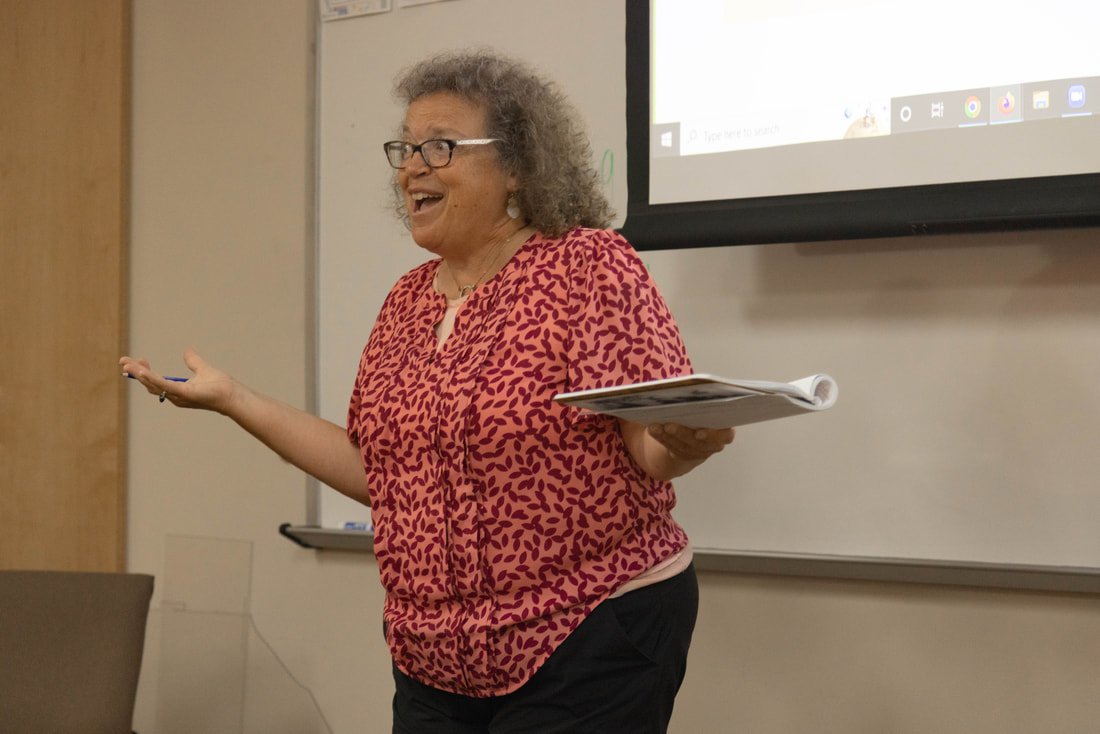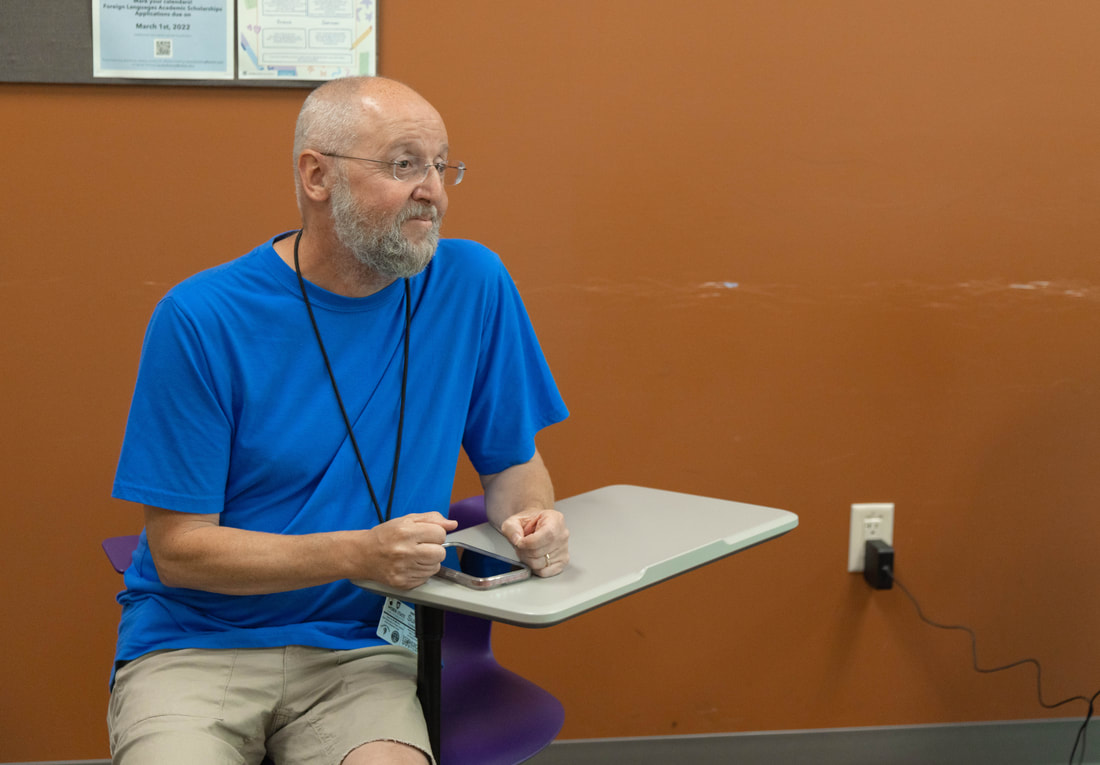July 14th: International Shakespeare and the MIT Global Shakespeare Archives w/Alexa Joubin8/19/2022 In the afternoon of July 14th, we were once again thrilled, honored, and excited to have Dr. Alexa Alice Joubin (George Washington University) Zoom into our classroom. Not only did she continue her previous topic of "Globalization of Shakespeare," but she presented us all with unique pedagogical practices that we can incorporate into daily classroom life, increasing the self-efficacy of students.
Our class began with Dr. Joubin explaining the importance of close reading/close screening of specific scene(s) while preparing lessons. When preparing a lesson, consider first doing a close reading of a specific passage of the text, such as the "To be or not to be" text found in Hamlet. After the close reading, Dr. Joubin recommended to not just watch specific adaptations of the text, but also to have students analyze the differences, cultural aspects, music behind the scenes, and the cultural conflicts of the scenes in order to facilitate conversations centered around different cultural aspects and interests. Dr. Joubin modeled this pedagogical practice for us by having us discuss our familiarity with the "To be or not to be" text from Hamlet. After this, she showed us three different adaptations of the text. The first was the Branagh version, the second clip was taken from the online video game Mabinogi, and the third clip was from the Almeredya version of Hamlet starring Ethan Hawke. Before, and after, showing us these three different adaptations, she used Google Jamboard as an interface for us to discuss specific differences and thoughts on the three different adaptations. One of the best modeling pieces she used was that she would often provide information about each clip, not being afraid to stop the clip to make sure we, as a class, were all on the same page. I often find myself hesitant to stop a video while showing it, but I'm happy that Dr. Joubin showed what rich conversation can come from periodically stopping a short clip to further explain detail and specific cultural references that might be foreign to us and to students. Using two to three short videos will help students stay focused on the different adaptations and not feel lost. Specific grouping strategies will also allow students to increase their familiarity with the material, but also their self-efficacy. Dr. Joubin recommended to group students and have them identify the following:
As a class, we also discussed the importance of talking about, and implementing, "Global Shakespeare" within our schools and districts. The different adaptations, found throughout the world, approach Shakespeare with curiosity, and it is not just "white canon," but an opportunity for students and educators alike to delve into the beauty and richness of such diversity, conflict, and "otherness" that creates the melting pot of everlasting dramatic pieces. Dr. Joubin empowered me to incorporate these different pedagogical practices into my classroom and also to advocate for teaching Global Shakespeare, not just Shakespeare through one lens. Our role is not just to have students be able to remember Hamlet in twenty years, but to give them skill sets that will help them understand different global communities and the importance of how adaptations are unitive in function, helping to transcend borders and helping to highlight the versatility and transcendence of Shakespeare. Please follow the links below to access the main websites that were discussed in this session: MIT Collection of Shakespeare Adaptations (by play) How to Write a Rationale to Administration & Board (You might need to create a NCTE account if you do not already have one - a great resource for defending books and plays in the current climate)
0 Comments
“My duty kneeling, came there a reeking post” One question that comes up when people find out I teach English is “What’s your favorite play?” When it comes to Shakespeare’s tragedies, it’s Lear. I love the complexity of the relationships between the siblings, I love the dual plot lines, I love the ambiguity of the settings, I love the extremes of the emotions and mostly, I really love the villains. Even when I was a kid, I gravitated toward the bad guys. Growing up, I myself, was terribly afraid to get in trouble with my parents, so the bad guys were sort of my heroes, the people who weren’t afraid to break the rules. King Lear was the first play I studied academically and I instantly fell in love. I’m going to get into more depth with the play itself and my interpretations when I write about the Festival performance we saw in Cedar City in my next blog, but here I’m going to discuss Scott’s lecture from 14 July called “King Lear: Doing Shakespeare in Different Ways.” Because I love Lear, learning about the backgrounds, both of the history of the story and the history of the text of the play is a subject I’m enthralled with and I think it’s important to know that too, especially if you’re teaching the plays. I’m of the mind where I want to be as informed as I possibly can be. I’m always afraid a student will ask a question I can’t find the answer to. I want to give them the information they want. Of course, I know they won’t always ask on their own, but if I say “King Lear was published in several forms before this one,” maybe they’ll wonder why this is the one we’re reading, or why it changed. I find when the students are genuine about the things they want to know, we can introduce much more. Yes, sometimes the lessons go off the rails, but many times it arrives at the same station, but we took a different route and that’s good too. I also find that it demystifies Shakespeare to show that other people have edited or modified the text in some way. When I give them lessons like we did in class - cutting a speech in half or more to get to the bare bones of it, showing the professionals did it too makes it a little easier to do in class. Though, watching their anxiety grow when line after line is being redacted is a delight made better by their defenses of the lines. But I digress. Like much of the Bard’s work, there is quite a bit of borrowing from previous sources, something of a usual practice at the time. Scott’s lecture covers in great detail the history of the Lear story going back to Geoffrey of Monmouth (1095-1155), who is generally associated with King Arthur. For me, because I like the history of things anyway, it’s a slippery rabbit-hole indeed when I really like something and Lear is one of those things. The people of the time would have known some of that history not unlike the people of ancient Athens who knew some of the stories that had come before them, so when they went to see a play, they went to see how the story looked “this time around.” Not unlike how Spiderman keeps coming back around every few years.
Scott’s lecture spent some time focusing on Lear’s Fool. An important character as Fools in the plays serve an important purpose, that of speaking truth to power. Scott also cited Edwin Booth who pointed out “the Fool should be a man who has both humor and pathos and be able to sing.” The humor and singing is clear, as it tempers the tragedy and illuminates various points, but it’s the pathos which is most important; it’s through his eyes in which we see just how far Lear falls. Now this is where Scott and I diverge, though we agree on many other points. Again, however, I’ll speak more to that when I discuss the performance.
Scott makes interesting points in focusing on the Fool and how this character serves not only Lear, but us the audience. The audience would have been familiar with the role of the Fool on stage and in real life. That this wasn’t just a fictional role, it was a trade and profession, brings some gravitas to the character on stage. Scott’s research project discusses the Fool’s role as a barometer to the stability of the court. In my undergrad, I was taught we pay attention to the king - “how goes the king, so goes the kingdom” was the mantra when discussing national stability, but this focus on a lesser, seemingly minor courtesan is very interesting. That’s the thing with Shakespeare’s characters, they are all interesting if the eye is drawn to them. Consider Oswald, Goneril’s man, is he really “Goneril’s man” or is he Albany’s man and offended by Goneril’s actions with Edmund? If he’s Albany’s man, then there could be a different audience reaction by his death at the hands of Edgar. With the Fool, Scott argues by keeping on eye on Lear, we can see the court disappearing symbolized by the shedding of the clothing, layer by layer and once it has evaporated on the heath, the Fool can no longer exist as a Fool and must disappear. Scott further suggests the “1606 audience, well versed in absolute monarchical power and the roles of fools and courts, would have likely been at least put on guard by the disappearance, preparing them for an ending that they otherwise would never have expected.” This is where Scott and I think differently. I don’t have that much faith in the 1606 audience to be as versed in courtly affairs in real life as much as they would have been in theatrical life. But, more on that to come next time. Hamlet and The Steep and Thorny Way:
Exploring Girlhood with Ariane M. Balizet I often ask my students to practice metacognition and intentional reflection through writing, and to them, it can seem abstract, tedious, meticulous, or simply repetitive. This is all before they go through the process. I find that challenges with reflection may stem from a simple lack of inspiration. Maybe it’s a lack of practice. Maybe it’s self-censoring as they are in the process of said reflection. This considered, and with me being very much a student in this institution, I am going to try to limit my own self-censorship and allow the ideas to appear on this page as they come – as true of a reflection as I might be able to convey. The session with Ariane Balizet from AddRan College of Liberal Arts left me with no lack of inspiration or things to say. I felt Ariane’s lessons left our group with plenty to take into our own classroom, and her visit certainly helped my small teaching group to have success teaching our own demonstration covering The Steep and Thorny Way. So, in that way, Ariane helped provide me with new thinking, real strategies, and real immediate teaching success in the week that followed! During our time with Ariane, I was impressed with many declarative statements that I have felt for the last few years in my own pedagogical practice but had not been able to coin, per se. Of all of what we learned from Ariane, the following two declarations stuck with me the most so I’d like to explore them a bit here: ● Declaration #1: Shakespeare belongs to young people ● Declaration #2: Adaptation allows for different kinds of student engagement and promotes the ability to measure student learning and skill development in more genuine and effective ways. __ __ __ __ __ __ __ __ __ __ __ __ __ __ __ __ __ __ __ __ __ __ __ __ __ __ __ __ __ __ __ __ __ __ __ Declaration #1: Shakespeare belongs to YOUNG people. Ah! Finally. What a relief. Someone who has deeply studied pedagogical practices for teaching Shakespeare defines this truth and does so within a scholarly framework. To many in my local teaching community, Shakespeare is seen as a sort of unattainable, highbrow drama meant to be absorbed by white, retired fuddy-duddies who seek entertainment and false sophistication on a Saturday night. Or, people in my local community see it as an unattainable text because students “just don’t need it anymore.” More sadly, they say we can’t “do Shakespeare” because students just can’t handle – or won’t TRY to handle – the challenge anymore. Just this year, a colleague abandoned Othello because he feared our students “don’t recognize Shakespeare’s relevance anymore and won’t like it.” I vehemently disagree with the above interpretations and about the study of Shakespeare. Shakespeare belongs to PEOPLE would have been a relief to hear Ariane say during this lesson. I would have left the class with a kind of permission to continue exploring adapted and creative renditions of his story. But what she said is more nuanced. More pointed. According to Ariane, Shakespeare belongs to the people, sure, but it might be more valuable to consider “ownership” in a different way. The following phrase left me with a lot of promise for my teaching future. Shakespeare belongs to YOUNG people. I think the error of those hesitant to teach Shakespeare falls within the idea that I, the instructor, must be an expert in His works, must have authority over My reading, line-by-line, and I must have such Robin-Williams-Dead-Poet-Prowess as to deliver each lesson with such perfection as to leave students wanting to create their own Shakespeare club. I don’t believe this, and I have never believed this. I also don’t think Ariane believes this. Instead, Ariane premised that WE (educators, adults, or even Shakespeare himself) should not be burdened with the idea that we must own the story. If we attack the challenge and beauty of Shakespeare with the idea that it belongs to young people, we can be relieved of these false pressures and let the story bloom in its own time in its own way in our students’ minds. Each generation seeks their own path of exploration and understanding of the world around them, and so by giving THEM the ownership of Shakespeare’s story, we can all seek a higher, more genuine, more critical understanding of what his storytelling can do. This is step one to an important and essential shift in teaching Shakespeare to high school sophomores and seniors. Declaration #2: Adaptation allows for different kinds of student engagement and promotes the ability to measure student learning and skill development in more genuine and effective ways. Again, hearing Ariane say these words left me with a feeling of levity. I have been trying – and often failing – to explain how adapted works can be MORE beneficial than simply teaching the source material. If declaration #1 was permission to unpack Shakespeare in a different way, declaration #2 was permission to see this as a true, meaningful practice for modern classroom teaching practices. As said before, Shakespeare seems to be taught by fewer and fewer teachers across my district every year. I don’t want to be another the question the merits of teaching his stories, so hearing this in the classroom meant a lot to me. Ariane practices what she preaches, as well. I left this session with a myriad of tools and techniques I can use in my classroom on day one this coming school year, and for that I’m grateful. Her premise for adapting Shakespeare was backing by scholarly articles and real practices, and to have this nailed down will allow me to deliver my lessons more effectively and continue my own sort of scholarly meanderings within the world of this pedagogical model. Lastly, I myself feel that too often I approach Shakespeare while leaving students disenchanted or distanced from his works. Ariane’s lesson gave me methods for how I can use Shakespeare to genuinely build inclusive lessons and address some of the gaps in his own approaches to characters, especially girlhood. I often touch upon race, class, and gender when studying literature in my class, but Ariane has given me a fishbowl in which I can approach a more intersectional approach to 400+ year or Eurocentric storytelling. This year I will ask students to study and perform Shakespeare’s words, yes, but I will also feel more comfortable asking them to then reanimate his story in their own unique adapted project. Our first Wednesday brought us (live and in person) a class with Ariane Balizet to discuss Hamlet and different web series related to the play. She teaches at Texas Christian University in Fort Worth.
She explained why she teaches with adaptations of Shakespeare’s plays: it gives her students perspective on core ideas of literary analysis. We should remember that Shakespeare’s work itself was already adapted. Somehow, we have accepted the thinking that HIS adaptations are inherently superior. Careful, there. We talked about common themes we see in these adaptations, and the writing of Linda Hutcheon was cited (see the document in our folder, A Theory of Adaptation). Hutcheon’s work argues that we need to think of adaptations as works in and of themselves—as lateral, not hierarchical. Different web series relating to Romeo and Juliet, Macbeth, and Hamlet were reviewed and sampled. There was good class discussion about the value of teaching with adaptations. “The canon is always evolving,” Professor Balizet explained. Students want to work in a linear manner, but we must encourage them to “Move back and forth,” going between a play and a web series, for example. Lots of slides and resources and tons of new information for us today! My teaching group met with Mark to prepare our lesson so we participated in this lesson with Scott on the second afternoon. The stage had been set with a previous discussion and reading regarding Shakespeare and girlhood with Jenny on day one so we were ready to see media adaptations with Scott.
We began by learning about two actresses who played Hamlet as a female on stage and in films, Sarah Bernhardt in 1895 and Asta Nielsen in 1921. Scott explained that this stemmed from the nineteenth-century argument by Professor Vining declaring that Hamlet was a weak feminine character and could only be portrayed as a woman. Scott showed us clips from Asta Nielsen's performance where a nurse convinces Gertrude to say the daughter she just birthed is a boy and raise the princess as a prince. This is a silent film, making it universally accessible without language barriers. This adaptation brought up some points about gender and sexuality. We see Hamlet going to college (as a woman playing a woman pretending to be a man) providing commentary on women beginning to attend college in the 1920s. There was also homoerotic tension with Horatio since Hamlet as a woman could love him and they could be drawn to each other as friends. As Hamlet dies in Horatio’s arms it is revealed she is a woman and Horatio wastes no time closing the blouse to preserve Hamlet’s womanly modesty. In this adaptation, there is no Ophelia with Hamlet taking on elements of both characters in their performance. I really enjoyed seeing clips of this film and analyzing these clips through our discussion about how gender and sexuality can be represented or caricatured through adaptations. We also watched scenes from an all-female cast performing Julius Caesar from [the Donmar prison trilogy] to analyze social/economic status, race, age, and gender. The role of Caesar was played by a guard further emphasizing the commentary on power dynamics. I got goosebumps watching the final scene of the prisoners performing with one dynamic in the play and then juxtaposed with the reality of their limited power as prisoners. I really enjoyed seeing how powerful these adaptations can be and am very interested in seeing more of [Donmar trilogy]. Scott also mentioned Caleen S. Jennings’s “Elsewhere in Elsinore” as the perspective of what was happening from the perspective of the women behind the scenes of Hamlet. With all of these adaptations in mind, we were asked to look at recasting Hamlet in groups. Collectively we considered:
We had a lot of fun generating these ideas but also reflected on race, gender, and power. I could see my students loving this creative prompt and considering different possibilities for adapting the characters and the story. Alexa Joubin presented to us on “Radical Listening & Global Shakespeare.” During her presentation, Alexa provided us with access to MIT’s Global Shakespeare site which had various scenes from movies & reenactments of some of his plays. Alexa taught us that by looking at various scenes from the same play, from different cultures and time periods, teachers can assist students in finding their own meaning when watching and reading Shakespeare. This allows for Shakespeare’s works to become their own.
My favorite part of Alexa’s presentation was her ideas on visual language. She made a point to emphasize that it is very easy to assess and analyze a scene even if you do not speak the same language. A visually striking performance can tell the same story as a performance in a person’s native language. I do believe teaching students how to analyze and understand visual language is a great tool to help them draw (no pun intended) their own conclusions from plays such as Haider. Getting the chance to recognize that Shakespeare is translational is a big piece of what Alexa discussed. She gave us the chance to review the Duke’s famous lines in Othello, “if virtue no delighted beauty lack, your son-in-law is far more fair than black." When looking at these lines, Alexa provided a website that translated these lines in as many languages as possible. By doing so, she made a very important point. Everyone can translate and interpret Shakespeare’s words differently. It is important to recognize the choices a translator makes or doesn’t make. There is a choice to be symbolic or problematic in translating these lines. An exercise like this is a great way to get students more involved in the text they are reading but also allow them to recreate lines like these that they may have an issue with. Alexa’s presentation was super engaging and super informational. I cannot wait to use the resources she provided in my future classroom! Thank you Alexa! When I hear Shakespeare, the first thing that rarely crosses my mind is girlhood. Throughout most, if not all, of Shakespeare's great tragedies the main focus is on the torment and pain that the male lead is currently suffering. In contrast, many female characters, even those suffering in similar ways, are thought of as less than, villainous, or even hysterical. These girls and young women are forever viewed through this male gaze, taking away their agency, and making them something that is secondary despite their importance. However, as we began our discussion of Hamlet on our first day of our NEH Institute “Transforming Shakespeare’s tragedies”, Jennifer Flaherty (co-director of the program) had us focus not on our male lead, Hamlet, but on his love interest, the young woman Ophelia not as a “disturbed and neurotic” young woman, but as a character that represents girlhood in all of its complexity. As someone who has never taught Hamlet, my focus on girlhood in Shakespeare was Juliet, so I found it interesting how a character like Ophelia has become synonymous with girlhood and adolescence. Yet as we took a closer look into her character and circumstances, it became clear that much of what Ophelia struggles with, in her society and circumstances, can be used to gather a better understanding of our female students and the trials and tribulations of their adolescent lives. She, like many female students that I have encountered as a high school teacher, has been told by society that by a certain age if you do not fit the mold of what a young woman is supposed to be you will not be accepted among those in your friend group, society, or even your family. They are told, very much like Ophelia, that their self-worth is in connection to those around them and that they need to think about those around them and how to make others happy instead of themselves. Ophelia, like many adolescent girls, is solely focused through her connections with male characters such as Hamlet and her father Polonius which shows us only a shadow of who she is and what she could truly represent as a character. Ophelia is more than just a mad young woman but one with thoughts and feelings that she is unfortunately told to push down and repress. It is expressed that her feelings do not matter due to her being a young woman and not having a place in society to have a voice or express herself as Hamlet does. Yet, when we think of Ophelia as an individual and her connections to girlhood, we allow her to have a narrative separate from the male characters that control her life. As Jennifer Hulbert expresses in her article Adolescence, Thy Name Ophelia! The Ophelia-ization of the Contemporary Teen about Pipher’s work in Reviving Ophelia that “By removing Ophelia from the misogynistic world of Hamlet and declaring her and the girls she represents as the Self, these young women become people in their own right, no longer part of the definition of someone else” (205). Focusing on Ophelia separate from her ties to the men in her life, allows the reader to see her in a different light, to view her with agency and self-worth, and allows our students to do the same.
What do you think of when you hear the word “girlhood”? Dresses, dolls, and horses? First kisses, first dances, first crushes? In Shakespeare’s Hamlet, Ophelia has become the unofficial representative of girlhood and what it means, even as she unravels into insanity after she experiences the same, if not more, tragedy as the titular male character. During this symposium, we had the opportunity to discuss the effects that Ophelia as a character has had on society’s ideas of girlhood and what it means.
Ophelia is everything that a girl should be - polite, loving, devoted to her father and to her love, Prince Hamlet, despite his strange and erratic behavior after the death of his father, the king. She keeps the letters that Hamlet sent her; the little tokens of his feelings for her, though he tells her that he never meant them. Her father warns her against loving Hamlet, which could be any father telling any daughter: “Stay away from him, he won’t be good for you.” Her slow unraveling that culminates in her madness in Act 4, Scene 5, and ultimately her supposed suicide, could be the underpinning of girlhood that everyone ignores. How could she not unravel? She is at the mercy of every man in her life – rejected by the man she thought she would marry, controlled by her father, and at the whim of society’s expectations of what her life should look like. Her father is murdered and Hamlet vanishes to England, leaving her to the mercy of the court. Laertes, her brother, is basically off stage for the majority of the play. Ophelia has no one and her girlhood is interrupted. The promises of her life disappear and her madness manifests. I think that Ophelia would be a character that many frustrated, angry high school girls could cling to; told what to do by their parents, dictated by their expectations: go to college, get a good job, date a person we approve of, be successful but not too successful. What is their definition of girlhood? How do their parents and society condense them into one meaning, just like they condensed Ophelia? Ophelia’s madness could be a complete rejection of the idea of girlhood - good girls don’t go mad, don’t express their pain in clever little rhymes or hand out carefully picked flowers to the orchestrators of their madness. They are something else entirely. Or rather: could that anger, hurt, and damage be a function of girlhood in Ophelia’s society? After reading multiple interpretations from adaptations like Ophelia by Lisa Klein, and watching clips from the MIT Global Shakespeare database, students could decide their own interpretations of the mad scene - would they want to play into the hurt, or would they want to reclaim their fury? They could fling themselves to the floor, sing Ophelia’s little rhymes, hand out their flowers, or fool the King and the Queen who orchestrated so much tragedy. But the one that struck me the most was Julia Stiles in the Almereyda version. After trying to confront Gertrude, her words fail her; instead, Ophelia leans over the open railing of the Guggenheim and lets out a primal scream that echoes through the galleries. In the text, Shakespeare ties Ophelia’s madness into pretty rhymes, perfectly packaged with stanzas and rhythm - just like a girl should be pretty and perfectly packaged, neat and tidy even in her madness. Stiles and Almereyda burst through the seams, completely tearing it open by allowing Stiles to let out a violent, furious, frustrated scream over the edge of the railing for everyone in the museum to hear. Girlhood can mean a number of things - for Ophelia, it can mean tragedy, loss, heartache. It can mean being controlled until she’s not, and she controls her narrative when she comes in rhyming until the moment she falls into the water. And, really, what is girlhood if not letting out a primal scream over the railing of the Guggenheim, because no one will listen to you? Early on in the institute, I wanted to foreground the importance of starting with Shakespeare's language. Even as many/most Shakespearean adaptations stray from the original language, one of the more interesting bits about focusing on adaptation is in looking at how each one strays from the language. Case in point, I brought in several international versions of the play-within-a-play scene from Hamlet. What is the point/purpose of the play-within-a-play? What kind of space for interpretation is available in that scene? Why even produce Shakespeare if not in English? We explored all of these questions while looking at how each adaptation made the scene its own. In Russian director Grigori Kozintsev's version, he stayed fairly close to the text (and Olivier). In the Japanese film The Bad Sleep Well, director Akira Kurosawa added several additional layers to the scene. Nishi (the Hamlet figure) recruits Wada for the role of the Ghost by having Wada view his own funeral through the windshield of Nishi's car. Instead of using the play-within-a-play to gauge the guilt of the Claudius figure, Kurosawa uses it to show the reaction of another victim of this corrupt corporation. We see Wada react to the "play" of the funeral, but we also see/react to Nishi's manipulation of the scene in a larger way than we do in the play proper. In Indian director Vishal Bhardwaj's 2014 film Haider, we see the film center the conflict in Kashmir. His Hamlet figure (Haider, brilliantly played by Shahid Kapoor) performs his musical play-within-a-play at the wedding of his mother and uncle as a last ditch attempt to sway his mother away from the match. Rather than reveal his guilt, his uncle instead reveals his awareness of Haider's plot against him, and orders Haider's capture. Participants in the Institute found this scene so compelling that they ALL chose to watch the full version of Haider on our next Monday night movie night. Finally, in two Chinese adaptations--both released in 2006--the play within a play takes on drastically different tones. In Sherwood Hu's Prince of the Himalayas, his Hamlet figure (Prince Lhamoklodan) is barely involved in the play-within-a-play. Instead, the scene is arranged by the "Wolf Woman," a magical figure in contact with the ghost of Lhamoklodan's murdered father. She pushes back against the dark wishes of the murdered king, which sends the story spinning off into new (and fascinating) directions). In director Feng Xiaogang's The Banquet (released in the United States under the title The Legend of the Black Scorpion), the Hamlet figure (Wu Luan)'s father's ghost is minimized to a weeping suit of stationary armor. In this production, the queen is not Wu Luan's biological mother, but his beloved, whom his father (and afterwards his uncle as well) stole for himself. In the play-within-a-play, Wu Luan gives a performance intended to accomplish the same goals as Shakespeare's Hamlet--but here, the goal is as much reclaiming a woman he loves as it is vengeance for a father who, at best, wronged him. After Wu Luan's performance, his uncle gives a performance of his own, sending Wu Luan to an enemy as part of a treaty exchange. None of the characters speak directly, and so most of the meaning comes not from what they say, but rather what they don't say, and how they go about not saying it. By foregrounding Shakespeare's language and then pivoting to international adaptations of a scene, it becomes possible to study Shakespeare, other cultures, and adaptation simultaneously. Video clip comparison of the 5 international play within a play scenes. Please ignore the "Helena Rejected" caption on the title slide. I forgot to remove it when making this clip compilation.
Steven Estep |
| During the first class of our NEH Institute "Transforming Shakespeare's Tragedies," we encountered the "Eight Don'ts of Teaching Shakespeare'' from chapter 2 of Ralph Alan Cohen's book ShakesFear and How to Cure It (a copy awaits me at home already). This chapter includes all of the things that I typically do when I teach the immortal Bard. It's an old school mentality that I feel not only compelled to cover every line and scene of the play but also that I have a (divided) duty to improve their cultural literacy and make it relevant. |
The don'ts on this list include teacher favorites like memorization, films, stage productions, research, and reading aloud. Even with the author's caveat "except sometimes," it made me wonder...well, what DO I do? How did I get so much wrong? I am guilty of all these things, but then again, that's why I'm here this summer, to learn about what to do and how to do it better. I want to believe with all the reading aloud that my students did that they at least understood the plays better, or at least had fun while I read Lady Macbeth's "unsex me here" while splaying my arms wide or "screw your courage" or screamed "out damned spot" or even coaching them on how to read the words "what ho" as something other than a direct address. Even the opportunity to bring life to Dogberry's "you are an ass" was a great moment of fun.
As we looked further into what TO DO, I was much relieved because I also did these things more than I thought I did. Although I've not dealt with sound or staging, I have dealt with the dirty stuff and character. And now, I've only to figure out how to approach the concept of will in its many iterations. Thanks Jennifer [Institute co-Director Jennifer Flaherty] for that insight! Will will never be the same or is it will will never be the same. See what I did there? Leaning into the ambiguity there, folks. To be honest, students are much more adept at pointing out problems with the play and poor speakers, and I remember those moments clearly. I think, in all honesty, that we do these things much more than we give ourselves credit for.
Personally, I'm a sucker for those minor characters in anything and how they move the play forward or those minor words and gestures that, on a second or third or even fourth examination, yield something more fascinating than the major soliloquies or the primary characters. I am wont to overlook songs and even minor minor characters like "the gentleman" (except sometimes) but no more! Had it not been for this seminar, such ambiguities and tension would have continued to be overlooked. How fascinating now is that Gentleman and those songs that yielded far more meaning (except sometimes) than whether or not Hamlet has the propensity (dare I say testicular or intestinal fortitude) to act in any capacity. I'm a detail person so examining small things is not far out of my comfort zone (except sometimes). My daughter calls such characters Hopkins characters as a jab at me, but we've adapted that name to those minor characters whom we love although those characters are essentially silent or truly behind the scenes. Sometimes the blue shirt is just the blue shirt (except sometimes).
In the end, I think most of us have done it right or at least competently. Ralph Alan Cohen, though, has opened my eyes to more possibilities of the small things. And isn't it usually about the small things (except sometimes)?
As we looked further into what TO DO, I was much relieved because I also did these things more than I thought I did. Although I've not dealt with sound or staging, I have dealt with the dirty stuff and character. And now, I've only to figure out how to approach the concept of will in its many iterations. Thanks Jennifer [Institute co-Director Jennifer Flaherty] for that insight! Will will never be the same or is it will will never be the same. See what I did there? Leaning into the ambiguity there, folks. To be honest, students are much more adept at pointing out problems with the play and poor speakers, and I remember those moments clearly. I think, in all honesty, that we do these things much more than we give ourselves credit for.
Personally, I'm a sucker for those minor characters in anything and how they move the play forward or those minor words and gestures that, on a second or third or even fourth examination, yield something more fascinating than the major soliloquies or the primary characters. I am wont to overlook songs and even minor minor characters like "the gentleman" (except sometimes) but no more! Had it not been for this seminar, such ambiguities and tension would have continued to be overlooked. How fascinating now is that Gentleman and those songs that yielded far more meaning (except sometimes) than whether or not Hamlet has the propensity (dare I say testicular or intestinal fortitude) to act in any capacity. I'm a detail person so examining small things is not far out of my comfort zone (except sometimes). My daughter calls such characters Hopkins characters as a jab at me, but we've adapted that name to those minor characters whom we love although those characters are essentially silent or truly behind the scenes. Sometimes the blue shirt is just the blue shirt (except sometimes).
In the end, I think most of us have done it right or at least competently. Ralph Alan Cohen, though, has opened my eyes to more possibilities of the small things. And isn't it usually about the small things (except sometimes)?
Sarah Pierce
English Department
Athens Drive Magnet HS
Raleigh, NC
| As a young teacher at the beginning of my career, taking the leap to attend a 2.5-week institute with more experienced and seasoned teachers who were all complete strangers was scary to say the least. Even when applying, I felt like I didn’t have the knowledge or skills necessary to justify my attendance at an institute meant to explore how to teach Shakespeare effectively. This was even reinforced during our pre-trip Zoom meetings, when I was consistently one of the least experienced in terms of teaching Shakespeare. I have only ever taught Romeo & Juliet, so I felt like my inexperience was apparent in every conversation. |
In addition to my lack of knowledge about Shakespeare, I also felt that as one of the youngest attendees, I would be taking away a lot more from this experience than I could bring to the table. I feared that my lack of experience would be seen as a detriment, and that I would be unable to give much insight or suggestions in terms of teaching strategies or conversations about pedagogy.
I was pleasantly surprised upon landing in Salt Lake City, Utah to realize that my fears were unfounded. My initial trip from the airport to Ogden with two other attendees was filled with conversation about our various years of teaching experience, former NEH institutes attended by the others, and great discussion about what we were most looking forward to for the next 2.5 weeks. Right away, I felt comfortable and in my element by this chance to chat with other teachers about what we love. This feeling only continued to grow as I took advantage of little moments to talk with my roommates, make friends with others at the institute, and find ways to learn from everyone in unexpected ways. Despite being newer in my career, I also found that others were willing to learn from me as well. I was able to bring new ideas and strategies that they hadn’t thought of or tried themselves.
This environment of mutual learning was encouraged in the classroom as well. Daily lessons were dense and full to the brim with knowledge about Shakespeare and teaching, so I was absolutely saturated with new information. While this was at times overwhelming, I could also tell that every person in the room was getting so much out of this experience, whether a young teacher like myself or a veteran teacher of 30 years. This helped to assuage the nerves I had about being so inexperienced with Shakespeare, because everyone was learning something new. I only had to take in what I could and work to process how to use these things in my own classroom and teaching practice.
As I reflect on both my initial expectations and concerns, as well as my actual experiences over the 2.5 week institute, I understand more than ever the importance of community and collaboration in the world of education. Despite being young and new in the profession, I have so much to bring to the table. Being around so many amazing and passionate educators reminded me of my why: students deserve to have access to quality, relevant, and engaging education, and I am so blessed to be a part of that mission. Educators are incredible humans, and the environment that an institute like this creates helps to bring like-minded people together to ensure that we have opportunities to learn from and with each other. I can’t recommend this experience enough, to teachers new and seasoned alike.
I was pleasantly surprised upon landing in Salt Lake City, Utah to realize that my fears were unfounded. My initial trip from the airport to Ogden with two other attendees was filled with conversation about our various years of teaching experience, former NEH institutes attended by the others, and great discussion about what we were most looking forward to for the next 2.5 weeks. Right away, I felt comfortable and in my element by this chance to chat with other teachers about what we love. This feeling only continued to grow as I took advantage of little moments to talk with my roommates, make friends with others at the institute, and find ways to learn from everyone in unexpected ways. Despite being newer in my career, I also found that others were willing to learn from me as well. I was able to bring new ideas and strategies that they hadn’t thought of or tried themselves.
This environment of mutual learning was encouraged in the classroom as well. Daily lessons were dense and full to the brim with knowledge about Shakespeare and teaching, so I was absolutely saturated with new information. While this was at times overwhelming, I could also tell that every person in the room was getting so much out of this experience, whether a young teacher like myself or a veteran teacher of 30 years. This helped to assuage the nerves I had about being so inexperienced with Shakespeare, because everyone was learning something new. I only had to take in what I could and work to process how to use these things in my own classroom and teaching practice.
As I reflect on both my initial expectations and concerns, as well as my actual experiences over the 2.5 week institute, I understand more than ever the importance of community and collaboration in the world of education. Despite being young and new in the profession, I have so much to bring to the table. Being around so many amazing and passionate educators reminded me of my why: students deserve to have access to quality, relevant, and engaging education, and I am so blessed to be a part of that mission. Educators are incredible humans, and the environment that an institute like this creates helps to bring like-minded people together to ensure that we have opportunities to learn from and with each other. I can’t recommend this experience enough, to teachers new and seasoned alike.
Lynne Donohue
English Department
Toronto HS
Toronto, OH
| Adaptations of Shakespeare….Utah…three weeks…away from my family, my friends and out of my comfort zone. BUT….it’s Shakespeare!!! And it’s three weeks! Away from home…and out of my comfort zone!! It’s safe to say that I’m just a little scared, and a little excited, and a little hesitant to push the submit button. Am I qualified? Am I what they are looking for? Am I ready for something this intense? Yet again…it’s Shakespeare! Surrounded by people who GET IT…three intense weeks of eating, breathing and discussing my most favorite topic. In a place I have never been, with people I have never met, with a chance of traveling, road tripping, and the ultimate hotel stay! SUBMIT! |
Now the waiting…will they accept me? Can I afford the time away from home? Can my girls handle my time away? I’ve never been away from them longer than a night. Lists would need to be made, recipes, and rules established. Schedules gone over and contacts made to make sure that they want for nothing and miss out on nothing while I’m gone…..if I will be gone. There’s the question still of IF I will make it. The waiting game is torture. But I need to set things in motion as if I will.
Sooo…I got an e-mail…I didn’t make it. I’m on a waiting list. Apparently, I’m “high on the list” and I should remain hopeful, but I have received letters like that before, and I cannot say that I’m not disappointed. I was really, really hopeful for this. I really, really wanted and needed this. I felt like I was made for this, that I truly was meant for this experience. I was more than let down. I’m tempted to apply for another, but I know that I was meant for this one. Sigh….
I GOT IN!!!! I know that my getting in meant someone else dropped out, but at this point, I don’t care. I'm in!! In a few months, I will be loading my car, and driving across the country, through areas I have never been. This is scary, it’s new, it’s exciting, and oh so scary. Did I say scary? Zoom conferences to prepare for, and books to grab, and arrangements to be made. I hate Zoom conferences, but I love traveling. I love reading, I love Shakespeare, and I so cannot wait for July. It’s going to be hot, I’m going to be exhausted, and so mentally challenged, that I don’t think it can come soon enough!
“I am to wait, though waiting so be hell”
(Sonnet 58: That God Forbid, That Made Me First Your Slave)
Sooo…I got an e-mail…I didn’t make it. I’m on a waiting list. Apparently, I’m “high on the list” and I should remain hopeful, but I have received letters like that before, and I cannot say that I’m not disappointed. I was really, really hopeful for this. I really, really wanted and needed this. I felt like I was made for this, that I truly was meant for this experience. I was more than let down. I’m tempted to apply for another, but I know that I was meant for this one. Sigh….
I GOT IN!!!! I know that my getting in meant someone else dropped out, but at this point, I don’t care. I'm in!! In a few months, I will be loading my car, and driving across the country, through areas I have never been. This is scary, it’s new, it’s exciting, and oh so scary. Did I say scary? Zoom conferences to prepare for, and books to grab, and arrangements to be made. I hate Zoom conferences, but I love traveling. I love reading, I love Shakespeare, and I so cannot wait for July. It’s going to be hot, I’m going to be exhausted, and so mentally challenged, that I don’t think it can come soon enough!
“I am to wait, though waiting so be hell”
(Sonnet 58: That God Forbid, That Made Me First Your Slave)
Author
25 teachers gathered in Ogden, Utah to work together and learn about Shakespeare and Adaptation from three regular and several visiting faculty. These are their stories.













 RSS Feed
RSS Feed



